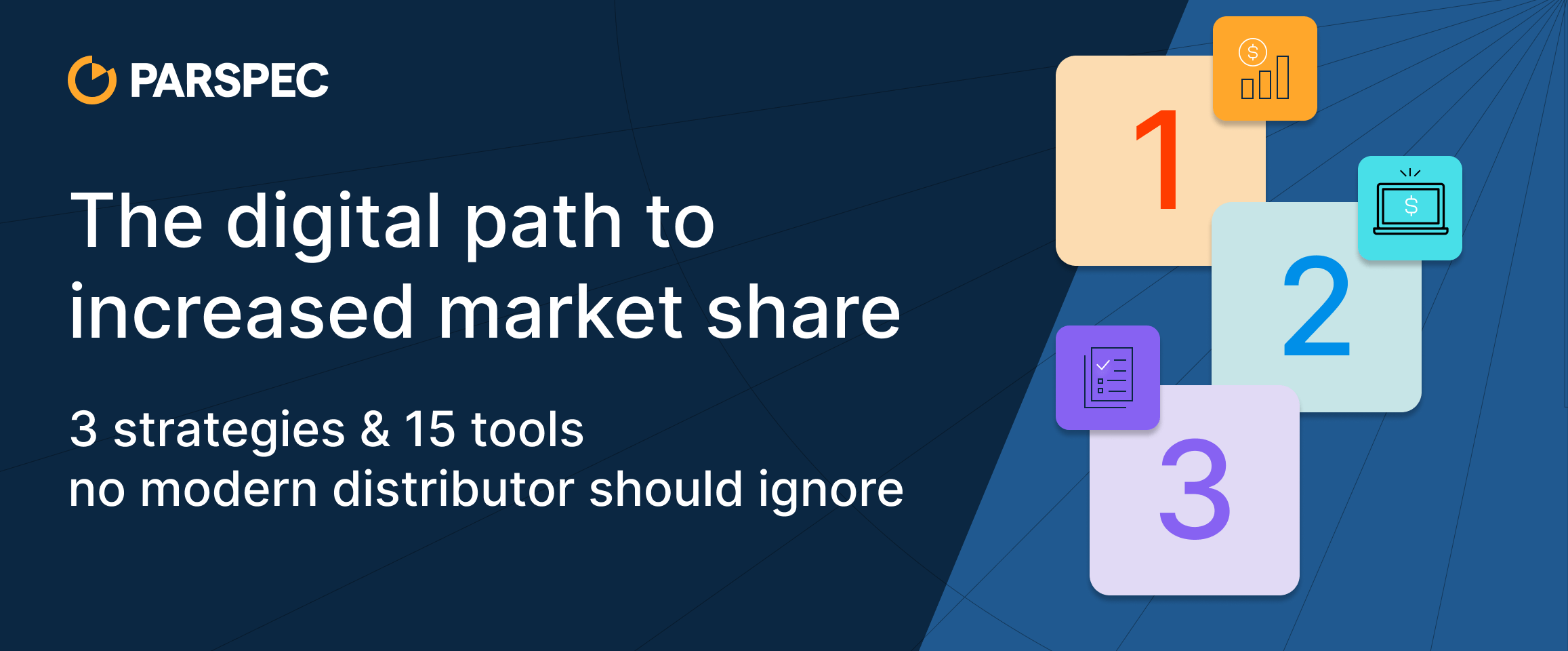
3 strategies & 15 tools no modern electrical distributor should ignore
Electrical distributors are at a pivotal and exciting juncture. The industry, much like many others, is undergoing a transformation, influenced by powerful trends that have reshaped global markets. This is an era of opportunity for those ready to embrace change. But, while some distributors are rapidly scaling up their operations, and creating seamless, omnichannel experiences that customers crave, others risk falling behind – reminiscent of the fates of Blockbuster and Borders.
Two major challenges force distributors into new ways of thinking:
|
Challenge 1
Rising customer Customers today want it all: |
Challenge 2
Disruptive new entrants Digital-first behemoths are agile, tech-savvy, and shaking up the market. While distributors still hold a few aces – differentiated product catalogs, great sales relationships, and technical expertise – this edge may not last without innovation. |
The good news: digitization can combat these forces, offering clear pathways to drive stronger margins and performance. Research shows distributors who invest heavily in digital can reduce building costs by up to 2.3% and project completion times by 15%, adding up to massive productivity and revenue gains.
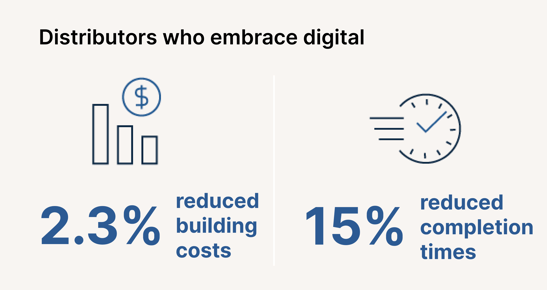
At Parspec, our goal is to help distributors adapt and succeed. In this guide, you’ll learn about three essential digital strategies and a set of tools that we believe will help the winners outperform in the next decade. Let’s get started.
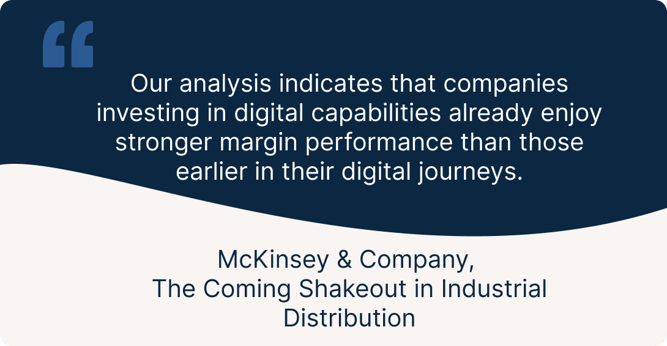
Three digital strategies for future-proofing your revenue
Mckinsey may have labeled construction product distribution as a digital laggard in their report on digitization, but change is on the horizon: Three out of four construction professionals say they’re eyeing increased investments in digital transformation. To fully realize these benefits, teams need the right training, data, and tools. Here are three pivotal areas where digital can make a big impact:
Strategy 1

Increase
revenue
with sales
enablement
Arming teams with tools and technology to support the sales cycle can accelerate the pipeline and increase both the number of deals and deal size while enhancing customer loyalty.
Strategy 2

Meet customer demands with a seamless eCommerce experience
Digital platforms can automate customer transactions, provide better UI, and offer features like smart pricing. This has proven impacts on sales and overall revenue.
Strategy 3

Improve margins
and efficiency
with automated
inventory management
Modern digital systems offer instant insights, and automate stock tracking and optimization, improving margins and efficiency across the board.
Strategy #1
Equip sales and project teams with the latest data and smart tools
In today’s construction market, a sales rep's knowledge and efficiency can make or break a deal. Customers now expect personalized communication tailored to their needs. This is especially true in construction sales where customers seek quick feedback from reps who are well-versed in their past purchases and specific needs.
Think of sales enablement as arming your team with a Swiss army knife of resources. From up-to-date product databases to tailored training sessions and comprehensive customer history, sales enablement ensures your team is primed to deliver fast, accurate quotes and proposals.
Six essential sales enablement strategies:
 |
Understand customer history: Grant your sales team direct access to comprehensive customer buying histories to make interactions more personalized and informed. |

|
Put the most accurate data at reps’ fingertips: Spec sheets change by the day – instead of requiring reps to manually track them down, invest in a product database that maintains the latest, accurate product specs across all manufacturers. |

|
Keep all documentation in one place: Establish a centralized content hub that can be easily updated, ensuring your team is all working off the most recent information. |

|
Prioritize industry training: Invest in continuous learning and where possible, 1:1 coaching, emphasizing the unique aspects of the AEC sector. |

|
Streamline revisions and communication: Implement a robust communication framework that facilitates easy revisions and fosters transparency with customers. |
|
|
Use comprehensive analytics tools: Employ platforms that offer detailed analytics on strategy performance, allowing your team to refine their approach based on real-world data. |
|
Tools in action:
Graybar saves 70+ Challenge: Graybar’s submittals team was bogged down with manual creation of quotes and submittals, reducing team productivity and causing client delays. What they did: Parspec’s comprehensive library of product data reduced time to submittal while its efficiency features simplified revisions and improved communication with contractors. Results: By leveraging Parspec, Graybar saves 70+ hours every month, translating to a 14x increase in ROI. The time previously spent on submittals is now focused on strategic tasks. |
Tools in action:
Distributor streamlines sales and engagement with Proton.ai to 3x revenue Challenge: A distributor, navigating a maze of products across multiple channels, needed help driving more proactive sales and improving customer engagement. What they did: By leveraging Proton.ai's dashboard for inside sales and a mobile app for outside reps, the distributor introduced systematic reorder reminders, cross-selling avenues, and specifically tailored campaigns. Results: The integration led to an immediate financial uplift with an attributed revenue of $1M, which tripled in the subsequent quarter. Weekly product pitches went from 300 to over 1000, and client’s gave kudos to the distributor for its solid sales approach. |
Strategy #2
Implement an eCommerce experience that meets buyer needs
Traditionally, construction distribution has been a more analog industry – relying on face-to-face meetings and phone calls with suppliers and contractors. But, in order to scale and meet the demands of modern buyers, things are starting to shift: 84% of construction companies predict they will sell their entire product catalog online in the future.
To do this effectively, distributors can implement an eCommerce experience – and so far, many aren’t building the experience consumers want. 95% of buyers have run into problems using construction ecommerce sites – calling out issues such as usability, lack of data, inaccurate data, and overly complicated re-ordering and checkout processes.
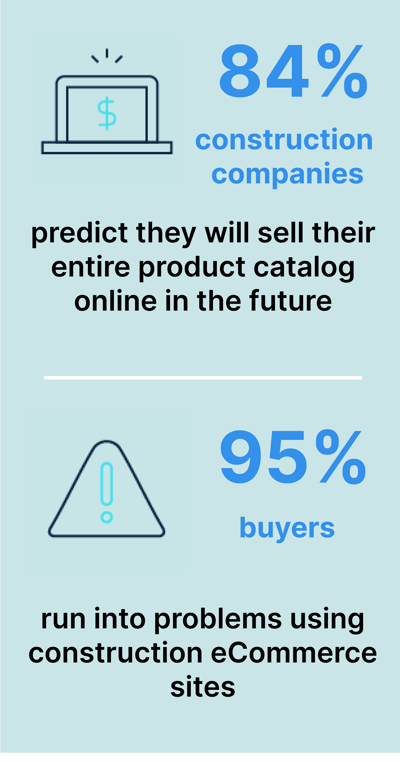
There’s good news, too: eCommerce platforms have proliferated in recent years, with platforms like Kojo and Unilog specializing directly in the AEC industry. By pairing the right strategy with supportive technology, you can easily up-level your site and build better buyer satisfaction.
Essential strategies to improve your eCommerce experience:

|
Digitize the entire ordering process: Streamlining requisitions, quotations, and purchase orders can significantly speed up procurement and reduce errors. Consider tools or platforms that allow for quick conversions of requisitions to RFQs or POs. |

|
Expand your online catalog: Customers and manufacturers told Mckinsey that the most important value distributors can offer is providing a broad range of available products. In fact, it even correlates strongly with performance. By partnering with industry leaders or eCommerce databases, distributors can significantly expand their product offerings without necessarily stocking these products in their brick-and-mortars. |

|
Synchronize systems with product inventory: Keep product details, images, and prices up-to-date. Real-time pricing and product availability allows for a more accurate and trustworthy shopping experience. |

|
Opt for responsive design: Buyers are often on the go, browsing on their phones or other devices. A responsive design ensures customers have a consistent experience, whether shopping on a desktop, tablet, or mobile. |

|
Prioritize online customer support: Allocate resources to assist online shoppers. Whether it's resolving issues, answering product-related queries, or guiding through the checkout process, a dedicated team can make a world of difference. |
|
Tools in action:
D&S Electric digitizes ordering + delivers materials to job sites 70% faster The challenge: D&S Electrical experienced delays and cost overruns due to materials procurement bottlenecks. Essential strategies: D&S employed Kojo, an eCommerce platform, to digitally process field orders, enabling swift conversions to RFQs or POs in the office. Now, the field team can instantly relay delivery confirmations, alerting the office to any potential problems. This system streamlines material quotes, cuts down on approval wait times, and integrates with the accounting framework, ensuring tighter coordination between procurement and financial operations. The results: Through the efficient utilization of Kojo, D&S Electrical has reduced their material delivery times, getting materials to the jobsite 70% faster. |
Tool
McGuckin Hardware expands online catalog and boosts sales by 1,320%. The challenge: McGuckin Hardware’s Commerce platform featured less than a third of their product line – despite having a large physical retail presence with 125,000 in-store items. What they did: McGuckin Hardware expanded their online catalog by partnering with Orgill and Unilog. They tapped into an extensive product database of over 800,000 items, dramatically enlarging their online presence. To adapt to changing consumer behaviors during COVID-19, they added a curbside pickup option. For an enhanced online experience, they also synchronized systems with product inventory for real-time pricing and product availability. The results: Thanks to these strategic initiatives, McGuckin Hardware not only doubled its web traffic but also achieved an 1,320% increase in online sales.s of action: |
Strategy #3
Transition to digital-first inventory management.
|
Inventory management isn't just a systematic approach to sourcing, storing and selling inventory – it's the heartbeat of a distributor's business. And, it’s increasingly complex, given the ever-growing number of SKUs sourced from hundreds of manufacturers. The ability to manage it effectively impacts both their bottom line and has cascading effects on industries they serve. 33% of customers told Mckinsey they want better product availability, with inventory levels that allow for a timely delivery of normal stock items. |
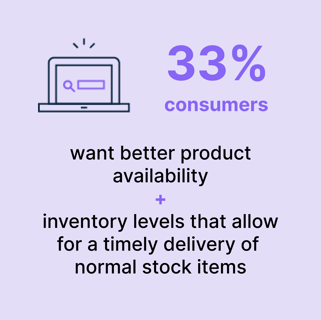
|
Digitization turns inventory management into a dynamic, real-time activity. Vendor Managed Inventory (VMI) systems offer always-accurate counts, digitized replenishment, sophisticated analytics and much more. They can prevent situations like stock-outs, which can damage your reputation and profitability, as well as ensure a smoother, more efficient workflow.
Four digital approaches to modern inventory management:

|
Transition away from manual: Digital inventory management solutions give you a more precise and real-time view of inventory levels and accuracy, with features like barcode generation, traceability, and multi-location management to manage stock across cities. |

|
Embrace digital replenishment: Leverage tracking software to save time, reduce paper waste, and optimize order accuracy and turnaround, minimizing manual errors. |

|
Unify your product views: All transactions, sales, and purchase orders should be unified under one platform, reducing confusion, errors and poor customer experience. |

|
Get oversight through analytics: Today’s tools offer a range of analytics and insights on inventory gaps, replenishment levels, and other critical data. |
|
Tools in action:
Distributor SMC implements a VMI to reduce procurement costs by 75% |
Tools in action:
A&M Kiln Dry reduces inventory issues and drives 33% growth with Acctivate |
15 digital tools reshaping distribution.
Sales Enablement
- Parspec: An AI-powered platform to support product selection, quoting, & submittals, featuring a database of more than 1.5M+ product specs from 1500 manufacturers.
- Conexiom: Automated sales order processing platform, allowing sales reps to focus on customer relationships and strategic selling.
- Sales-i: A sales enablement tool providing insights into customer data to drive proactive sales conversations.
- Proton.ai: Advanced AI-driven recommendations to optimize e-commerce personalization and sales strategies.
E-Commerce
- Kojo: An e-commerce platform designed for intuitive online shopping experiences.
- Kibo: A unified commerce platform offering solutions from order management to personalized marketing.
- Kentico: A content management and e-commerce system
- Big Commerce: A robust platform catering to various online retailers, ranging from startups to well-established businesses.
- Unilog: An all-inclusive e-commerce solution tailored for B2B businesses to improve online sales and interactions.
Inventory Management
- Epicor: A software solution designed for business growth, offering modules from CRM to inventory management.
- Verusen: AI-fueled inventory optimization, helping businesses reduce stockouts and excess inventory.
- eTurns - TrackStock: Provides real-time inventory visibility and demand forecasting to improve stock levels and reduce carrying costs.
- Brightpearl: An omnichannel retail management solution focusing on streamlining inventory management, order processing, and customer data in one platform.
- Enterprise 21: Comprehensive software offering a blend of enterprise resource planning and inventory management solutions.
- Acctivate: An inventory management software catering to multiple industries, offering tools from order processing to customer management.
We’re at a digital crossroads – which path will you take?
As distributors continue to confront new challenges, there's growing recognition that traditional methods won’t cut it. The good news? There's significant potential for you to lead the way in this transformation by embracing a few key strategies:

|
Equip sales and project teams with up-to-date insights, data, and tools. When they have the product and customer information they need, they stand to increase revenue and service clients more effectively. |

|
Craft a better online experience: Modern e-commerce platforms aren’t just about aesthetics—it's about accurate information in a user-friendly interface, paving the way for seamless transactions and customers who come back time and again. |

|
Bring inventory management into the 21st century: Distributors need real-time insights into stock, ensuring efficient operations and minimizing disruptions. |
By making the most of digital tools and forward-thinking strategies, distributors can address today's challenges and set themselves up for sustained success, long into the future.
.png?width=5504&height=1356&name=Colored%20Logo%20(1).png)




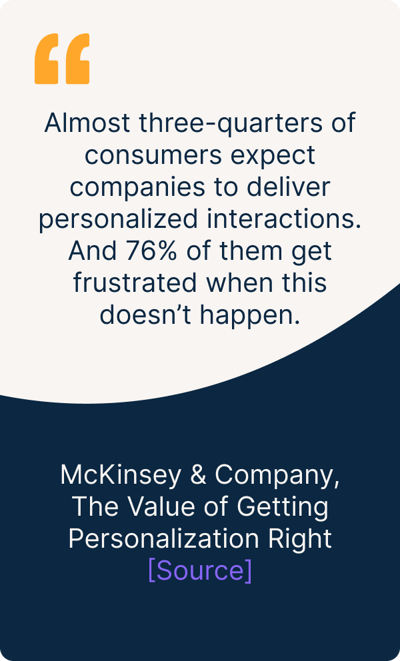









.png)
